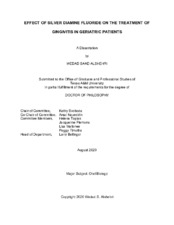| dc.contributor.advisor | Svoboda, Kathy | |
| dc.contributor.advisor | Noureldin, Amal | |
| dc.creator | Alshehri, Wedad | |
| dc.date.accessioned | 2020-10-14T18:09:42Z | |
| dc.date.available | 2022-08-01T06:54:33Z | |
| dc.date.created | 2020-08 | |
| dc.date.issued | 2020-07-21 | |
| dc.date.submitted | August 2020 | |
| dc.identifier.uri | https://hdl.handle.net/1969.1/189553 | |
| dc.description.abstract | Background: Gingivitis in the geriatric population is a growing public health concern. Finding an effective non-invasive approach to prevent and treat gingivitis is crucial and challenging. It was evident in many studies that silver diamine fluoride was effective in arresting dental caries because of its antibacterial activities. Silver diamine fluoride contains silver and fluoride ions. It has been shown that both ions have a role on inhibition of cariogenic biofilms. The potential of this agent to treat gingivitis had never been tested.
Objectives: This study investigated the effectiveness in clinical signs of inflammation following application of 38% silver diamine fluoride (SDF) to the gingiva of healthy geriatric patients with gingivitis. In addition, it determined whether SDF treatment has an effect on dental plaque accumulation after multiple applications.
Materials and Methods: This was a 7-week randomized, controlled, prospective double-blinded in-vivo study. Thirty geriatric participants (≥65-y old) with gingivitis; living in senior-retirement-homes; were identified based on inclusion criteria and randomly allocated to two groups (n=15 each). The experimental group received silver diamine fluoride (38%) applications while the placebo (saline group) received blue-tinted saline solution applications. Solutions were applied once a week for three consecutive weeks. Gingival index (GI) and Plaque index (PI) scores were obtained at baseline before treatment and at three follow up time-points (weeks 3, 5 and 7). Clinical intraoral photographs of teeth and gingivae were used for visual assessment of gingival health status. Results: Between-groups comparison revealed statistically significant reduction in the mean GI levels (p<0.05) using Löe-Silness gingival index and PI mean levels (Silness-Loe plaque index) (p<0.05) with visually less dental plaque accumulation and less signs of gingival inflammation (redness, swelling and bleeding) in silver diamine fluoride group compared to placebo group at all follow up time points starting week 3. No silver diamine fluoride-related adverse events were reported or observed. Conclusion: These results provide tangible evidence that silver diamine fluoride application is associated with better gingival health. Silver diamine fluoride has the potential to be a new adjunctive, cost effective and noninvasive tool for treating gingivitis. | en |
| dc.format.mimetype | application/pdf | |
| dc.language.iso | en | |
| dc.subject | Gingivitis | en |
| dc.subject | Gingival index | en |
| dc.subject | Plaque index | en |
| dc.subject | Dental plaque, Silver diamine fluoride | en |
| dc.subject | Geriatric | en |
| dc.title | Effect of Silver Diamine Fluoride on the Treatment of Gingivitis in Geriatric Patients | en |
| dc.type | Thesis | en |
| thesis.degree.department | Biomedical Sciences | en |
| thesis.degree.discipline | Oral Biology | en |
| thesis.degree.grantor | Texas A&M University | en |
| thesis.degree.name | Doctor of Philosophy | en |
| thesis.degree.level | Doctoral | en |
| dc.contributor.committeeMember | Tapias, Helena | |
| dc.contributor.committeeMember | Plemons, Jacqueline | |
| dc.contributor.committeeMember | Mallonee, Lisa | |
| dc.contributor.committeeMember | Timothe, Peggy | |
| dc.type.material | text | en |
| dc.date.updated | 2020-10-14T18:09:43Z | |
| local.embargo.terms | 2022-08-01 | |
| local.etdauthor.orcid | 0000-0003-4823-3578 | |


